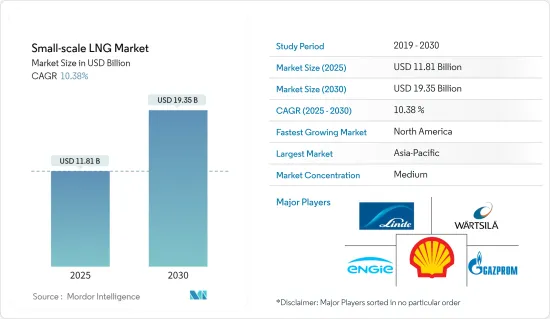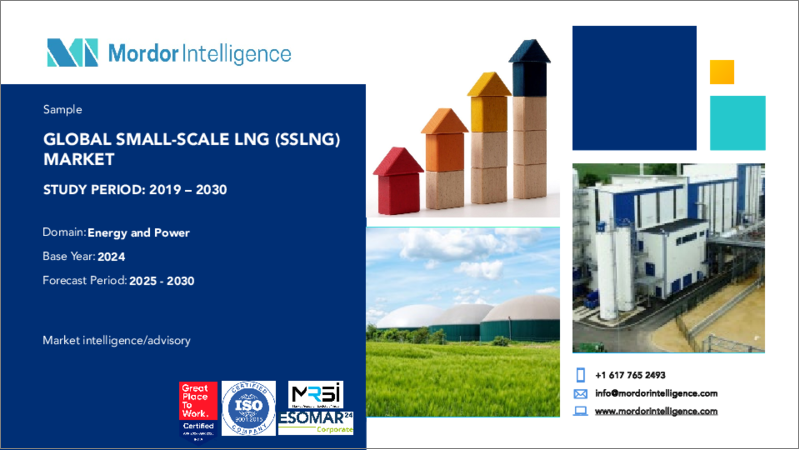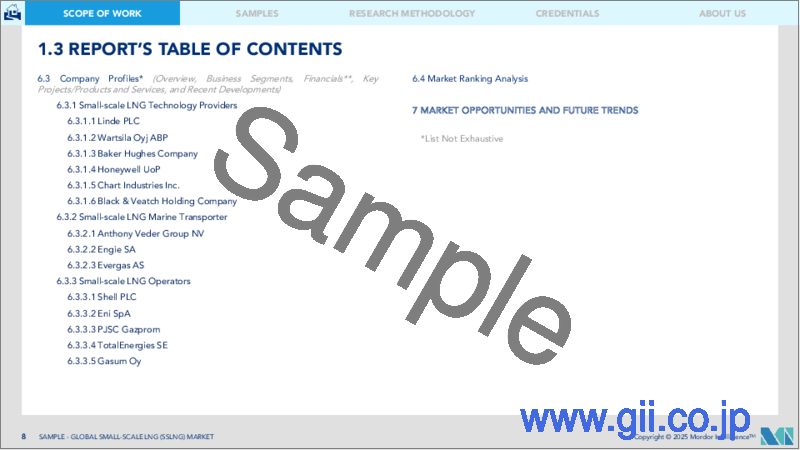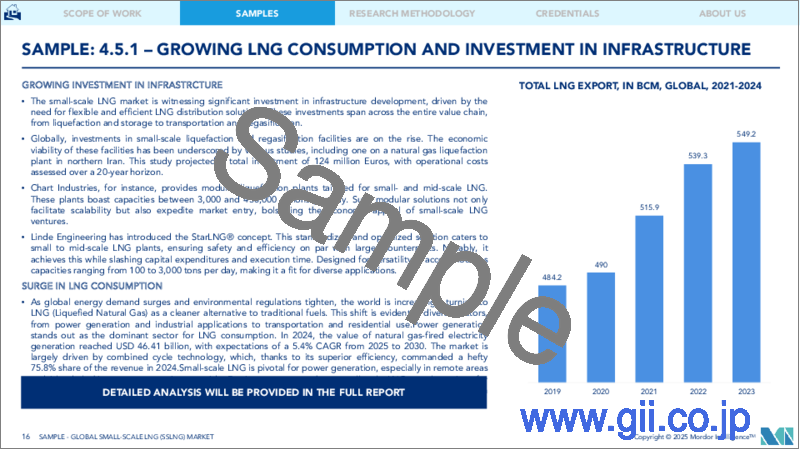|
|
市場調査レポート
商品コード
1687172
小規模LNG-市場シェア分析、産業動向と統計、成長予測(2025年~2030年)Small-scale LNG - Market Share Analysis, Industry Trends & Statistics, Growth Forecasts (2025 - 2030) |
||||||
カスタマイズ可能
適宜更新あり
|
|||||||
価格
| 小規模LNG-市場シェア分析、産業動向と統計、成長予測(2025年~2030年) |
|
出版日: 2025年03月18日
発行: Mordor Intelligence
ページ情報: 英文 200 Pages
納期: 2~3営業日
|
全表示
- 概要
- 目次
概要
小規模LNG市場規模は2025年に118億1,000万米ドルと推定され、予測期間(2025~2030年)のCAGRは10.38%で、2030年には193億5,000万米ドルに達すると予測されます。

主要ハイライト
- 長期的には、バンカリング、道路輸送、オフグリッド電力におけるLNG需要の増加などの要因が、今後数年間の小規模LNG市場を牽引します。
- その一方で、小規模LNGの運転コストが高いこと、中東やアフリカなどの地域ではそれを支えるインフラが不足していること、12年以上という長い投資回収期間とともにCAPEX要件が高いことなどの要因が、市場の成長を妨げると予想されます。
- しかし、小規模LNGインフラに必要な資本支出が高いため、費用効率の高い小規模LNGインフラの開発は、小規模LNG技術プロバイダーや輸送業者に大きな機会を提供すると予想されます。
- アジア太平洋が市場を独占しており、予測期間中に大きなCAGRで推移する可能性が高いです。
小規模LNG市場の動向
市場を独占すると予想される輸送セグメント
- LNGは主にトラックや船舶の燃料として使用されるが、その主要理由はディーゼルや燃料油に比べて経済的・環境的に優れているためです。LNGは腐食性がなく毒性もないため、自動車の寿命を最大3倍延ばすことができます。さらに、LNGは沸点が極めて低いため、高圧で気体状に変換するのに必要な熱量はごくわずかで、機械的エネルギーも無視できます。このため、LNGは効率的な輸送用燃料となります。
- わずかな温度差でも燃料の沸騰や気化につながるため、LNGの取り扱いは膨大な作業となります。そのため、乗用車は商用トラックなどの大型車よりもはるかに実用性が低いです。このため、輸送セグメントでのLNGの用途は限られています。
- 輸送用燃料としてのLNGの使用は、世界中で勢いを増しています。中国、米国、欧州はすでに、主に長距離貨物輸送用に、LNGを燃料とするトラックの配備を開始しています。これは主に、チャイナVIや欧州グリーンディールなど、脱炭素化や排出ガス規制に関する政府の施策と施策によるものです。
- 欧州委員会によって2019年に策定された欧州グリーンディールは、2050年までに欧州をカーボンニュートラルにするための一連の施策イニシアチブです。この施策では、目標達成におけるLNGの重要性が簡潔に強調されており、トラックや船舶の燃料としてのLNGの利用が強調されています。
- シェルLNG展望2024によると、2023年現在、469隻のLNG燃料船が運航中であり、537隻のLNG燃料船が発注中です。LNGを燃料とする船舶の発注量は、以前に比べて急速に増加しており、LNGの環境・気候面での利点を理解する船主やオペレーターが増えています。
- 新たな新興経済国もまた、将来の輸送用LNGの基礎を築くことを計画しています。例えば、ベンチャー・世界LNGは2024年3月、LNGフリートの建造を開始しました。このフリートには、現在韓国で建造中の9隻(貨物容量17万4,000m3が6隻、20万m3が3隻)が含まれます。
- したがって、上記の要因により、輸送セグメント向けの小規模LNGインフラに対する需要は、予測期間中に成長し、市場を大きく支配する可能性が高いです。
アジア太平洋が市場を独占する
- 近年、アジア太平洋は、世界的に小規模LNGプロジェクトを実施する先駆者となっています。中国、インド、シンガポール、日本などの国々で天然ガスの需要が高まるにつれ、小規模LNG(SSLNG)の利用に対する関心が近年高まっています。
- 中国は世界の主要国のひとつであり、これがLNG需要の増加につながりました。2022年のLNG輸入量は約6,440万トン。この需要の急増により、中国は世界最大のLNG輸入国のひとつとなりました。需要の増加は、中国のLNGバイヤーが年間2,000万トン以上の長期契約を結んだことによる。
- 中国の天然ガス市場には、国内生産とパイプラインやLNG基地経由の輸入があります。中国では、小規模LNGの需要が産業、住宅、発電セクターから高まっており、最も潜在力が高いのは運輸セクターです。天然ガスに比べてディーゼルの価格が高いため、LNGトラックの台数が増加していることが、中国で小規模LNG施設が増加している主要理由であると予想されます。
- インドでは、小規模LNGは非常に初期段階にあります。しかし、いくつかのLNGステーションがあり、LNGトラックによるLNG輸送が行われています。2030年までにエネルギーミックスに占める天然ガスの割合を15%まで高めるため、インドはパイプラインインフラのない遠隔地への天然ガス供給用に小規模LNG施設を建設する可能性が高いです。例えば、2022年6月、政府系の天然ガス探鉱・生産会社であるGAIL Limitedは、LNGパイプラインに接続されていない地域に小規模な液化施設を設置することを目指しています。
- 2024年3月、インドの石油天然ガス大臣は、GAILがマディヤ・プラデーシュ州のヴィジャイプルに設置した国内初の小規模LNGユニットを立ち上げました。
- シンガポールの港にあるLNGバンカリング施設は、シンガポールでの小規模LNGビジネスを大きく牽引しています。シンガポールは有数の貿易港であり、国際海運の世界的リーダーです。
- したがって、上記の点から、予測期間中、アジア太平洋が小規模市場の成長を支配すると予想されます。
小規模LNG産業概要
小規模LNG市場は細分化されています。同市場の主要企業(順不同)には、Linde PLC、Wartsila Oyj ABP、Shell PLC、Engie SA、PJSC Gazpromなどがあります。
その他の特典
- エクセル形式の市場予測(ME)シート
- 3ヶ月のアナリストサポート
目次
第1章 イントロダクション
- 調査範囲
- 市場の定義
- 調査の前提
第2章 エグゼクティブサマリー
第3章 調査手法
第4章 市場概要
- イントロダクション
- 2029年までの市場規模と需要予測(単位:米ドル)
- 最近の動向と開発
- 政府の規制と施策
- 市場力学
- 促進要因
- LNGインフラへの投資の増加
- バンカリング、道路輸送、オフグリッド電力におけるLNG需要の増加
- 抑制要因
- 中東やアフリカなどの地域におけるインフラ不足
- 促進要因
- サプライチェーン分析
- ポーターのファイブフォース分析
- 供給企業の交渉力
- 消費者の交渉力
- 新規参入業者の脅威
- 代替品の脅威
- 競争企業間の敵対関係
第5章 市場セグメンテーション
- タイプ
- 液化ターミナル
- 再ガス化ターミナル
- 供給形態
- トラック
- 積み替えとバンカリング
- パイプラインと鉄道
- 用途
- 輸送
- 工業用原料
- 発電
- その他
- 市場分析:地域別、2028年までの市場規模と需要予測(地域別)
- 北米
- 米国
- カナダ
- その他の北米
- 欧州
- ドイツ
- フランス
- 英国
- ロシア
- スペイン
- ノルディック
- イタリア
- トルコ
- その他の欧州
- アジア太平洋
- 中国
- インド
- 日本
- 韓国
- ベトナム
- マレーシア
- インドネシア
- オーストラリア
- その他のアジア太平洋
- 南米
- ブラジル
- アルゼンチン
- コロンビア
- その他の南米
- 中東・アフリカ
- サウジアラビア
- アラブ首長国連邦
- 南アフリカ
- エジプト
- カタール
- ナイジェリア
- その他の中東・アフリカ
- 北米
第6章 競合情勢
- M&A、合弁事業、提携、協定
- 主要企業の戦略
- 企業プロファイル
- 小規模LNG技術プロバイダー
- Linde PLC
- Wartsila Oyj ABP
- Baker Hughes Company
- Honeywell UoP
- Chart Industries Inc.
- Black & Veatch Holding Company
- 小規模LNG海洋輸送企業
- Anthony Veder Group NV
- Engie SA
- Evergas AS
- 小規模LNG事業者
- Shell PLC
- Eni SpA
- PJSC Gazprom
- TotalEnergies SE
- Gasum Oy
- 市場ランキング/シェア(%)分析
- 小規模LNG技術プロバイダー
第7章 市場機会と今後の動向
- コスト効率の高い小規模LNGインフラの開発
目次
Product Code: 55955
The Small-scale LNG Market size is estimated at USD 11.81 billion in 2025, and is expected to reach USD 19.35 billion by 2030, at a CAGR of 10.38% during the forecast period (2025-2030).

Key Highlights
- Over the long term, factors such as increasing demand for LNG in bunkering, road transportation, and off-grid power will drive the small-scale LNG market in the coming years.
- On the other hand, factors such as the high operation cost of small-scale LNG, lack of supporting infrastructure in regions such as the Middle East and Africa, and high CAPEX requirements, along with a long payback period of more than 12 years, are expected to hinder the growth of the market.
- However, owing to the high capital expenditure required for a small-scale LNG infrastructure, developing cost-efficient small-scale LNG infrastructure is expected to provide significant opportunities to small-scale LNG technology providers and transporters.
- The Asia-Pacific region dominates the market and will likely witness a significant CAGR during the forecast period.
Small-scale LNG Market Trends
The Transportation Segment Expected to Dominate the Market
- LNG is primarily used to fuel trucks and ships, mainly due to its economic and environmental benefits, compared to diesel and fuel oil. Since LNG is non-corrosive and non-toxic, it can extend the life of a vehicle by up to three times. Moreover, since LNG has an extremely low boiling point, very little heat is required to convert it into a gaseous form at high pressure, with negligible mechanical energy. This makes LNG an efficient fuel for transportation.
- Handling LNG is an immense task since even a slight difference in the temperature can lead to the boiling and vaporization of fuel, which, in turn, leads to fuel wastage. Therefore, it makes passenger cars far less viable than heavy vehicles, such as commercial trucks. This has limited the application of LNG in the transportation segment.
- The use of LNG as a transportation fuel is gaining momentum across the world. China, the United States, and Europe have already started deploying LNG-powered trucks, mainly for long-distance freight carriage. This is mainly due to the government policies and regulations on decarbonizing and emission control, such as China VI and the European Green Deal.
- Formed in 2019 by the European Commission, the European Green Deal is a set of policy initiatives to make Europe carbon-neutral by 2050. The policies briefly underline the importance of LNG in reaching the aim, and they emphasize the usage of LNG as fuel for trucks and marine vessels.
- According to Shell LNG Outlook 2024, as of 2023, there were 469 LNG-fueled vessels in operation, and 537 LNG-fueled vessels were on order. The rapidly growing order book for LNG-fuelled vessels has witnessed rapid growth compared to previous years, and increasing numbers of ship owners and operators understand LNG's environmental and climate benefits.
- New emerging economies are also planning to lay the foundation for the future of LNG for transportation. For instance, in March 2024, Venture Global LNG started the construction of a new large fleet of LNG-powered vessels. The fleet includes nine vessels (Six vessels having a cargo capacity of 174,000 m3 and three with a cargo capacity of 200,000 m3) currently under construction in South Korea.
- Hence, owing to the above-mentioned factors, the demand for small-scale LNG infrastructure for the transportation segment will likely grow and significantly dominate the market during the forecast period.
Asia-Pacific to Dominate the Market
- In recent years, Asia-Pacific has been a pioneer in implementing small-scale LNG projects globally. Interest in using small-scale LNG (SSLNG) has increased in recent years as the demand for natural gas increases in countries like China, India, Singapore, and Japan.
- China is one of the world's major countries, which led to the growth in LNG demand. LNG imports totaled around 64.4 million tons in 2022. Due to this surge in demand, China became one of the world's largest LNG importers. The increased demand is due to Chinese LNG buyers signing long-term contracts for more than 20 million tons annually.
- China's natural gas market includes domestic production and import via pipelines and LNG terminals. In China, the rising demand for small-scale LNG is from the industrial, residential, and power generation sectors, with the highest potential being in the transportation sector. Growth in the number of LNG trucks due to the higher price of diesel, compared to natural gas, is expected to be the prime reason small LNG facilities are growing in China.
- In India, small-scale LNG is in a very nascent stage. However, there are a few LNG stations where LNG transportation through LNG trucks is taking place. To increase the share of natural gas to 15% in its energy mix by 2030, India will likely construct small-scale LNG facilities for natural gas supply to remote places with no pipeline infrastructure. For instance, in June 2022, GAIL Limited, a government-owned natural gas explorer and producer company, aimed to set up small liquefaction facilities for areas not connected to LNG pipelines.
- In March 2024, the Union Minister of Petroleum and Natural Gas of India launched the country's first small-scale LNG unit set up by GAIL at Vijaipur in Madhya Pradesh.
- The LNG bunkering facilities in the ports of Singapore majorly drive small-scale LNG business in Singapore. Singapore has one of the leading trade ports and is one of the global leaders in international marine shipping.
- Therefore, owing to the above points, Asia-Pacific is expected to dominate the growth of the small-scale market during the forecast period.
Small-scale LNG Industry Overview
The small-scale LNG market is semi-fragmented. Some of the major players in the market (in no particular order) include Linde PLC, Wartsila Oyj ABP, Shell PLC, Engie SA, and PJSC Gazprom.
Additional Benefits:
- The market estimate (ME) sheet in Excel format
- 3 months of analyst support
TABLE OF CONTENTS
1 INTRODUCTION
- 1.1 Scope of the Study
- 1.2 Market Definition
- 1.3 Study Assumptions
2 EXECUTIVE SUMMARY
3 RESEARCH METHODOLOGY
4 MARKET OVERVIEW
- 4.1 Introduction
- 4.2 Market Size and Demand Forecast in USD, till 2029
- 4.3 Recent Trends and Developments
- 4.4 Government Policies and Regulations
- 4.5 Market Dynamics
- 4.5.1 Drivers
- 4.5.1.1 Increasing Investment in LNG Infrastructure
- 4.5.1.2 Rising Demand for LNG in Bunkering, Road Transportation, and Off-grid Power
- 4.5.2 Restraints
- 4.5.2.1 Lack of Supporting Infrastructure in the Regions such as the Middle East and Africa
- 4.5.1 Drivers
- 4.6 Supply Chain Analysis
- 4.7 Porter's Five Forces Analysis
- 4.7.1 Bargaining Power of Suppliers
- 4.7.2 Bargaining Power of Consumers
- 4.7.3 Threat of New Entrants
- 4.7.4 Threat of Substitutes Products and Services
- 4.7.5 Intensity of Competitive Rivalry
5 MARKET SEGMENTATION
- 5.1 Type
- 5.1.1 Liquefaction Terminal
- 5.1.2 Regasification Terminal
- 5.2 Mode of Supply
- 5.2.1 Truck
- 5.2.2 Transshipment and Bunkering
- 5.2.3 Pipeline and Rail
- 5.3 Application
- 5.3.1 Transportation
- 5.3.2 Industrial Feedstock
- 5.3.3 Power Generation
- 5.3.4 Other Applications
- 5.4 Geography (Regional Market Analysis {Market Size and Demand Forecast till 2028 (for regions only)})
- 5.4.1 North America
- 5.4.1.1 United States
- 5.4.1.2 Canada
- 5.4.1.3 Rest of North America
- 5.4.2 Europe
- 5.4.2.1 Germany
- 5.4.2.2 France
- 5.4.2.3 United Kingdom
- 5.4.2.4 Russia
- 5.4.2.5 Spain
- 5.4.2.6 NORDIC
- 5.4.2.7 Italy
- 5.4.2.8 Turkey
- 5.4.2.9 Rest of the Europe
- 5.4.3 Asia-Pacific
- 5.4.3.1 China
- 5.4.3.2 India
- 5.4.3.3 Japan
- 5.4.3.4 South Korea
- 5.4.3.5 Vietnam
- 5.4.3.6 Malaysia
- 5.4.3.7 Indonesia
- 5.4.3.8 Australia
- 5.4.3.9 Rest of the Asia-Pacific
- 5.4.4 South America
- 5.4.4.1 Brazil
- 5.4.4.2 Argentina
- 5.4.4.3 Colombia
- 5.4.4.4 Rest of South America
- 5.4.5 Middle East and Africa
- 5.4.5.1 Saudi Arabia
- 5.4.5.2 United Arab Emirates
- 5.4.5.3 South Africa
- 5.4.5.4 Egypt
- 5.4.5.5 Qatar
- 5.4.5.6 Nigeria
- 5.4.5.7 Rest of the Middle East and Africa
- 5.4.1 North America
6 COMPETITIVE LANDSCAPE
- 6.1 Mergers and Acquisitions, Joint Ventures, Collaborations, and Agreements
- 6.2 Strategies Adopted by Leading Players
- 6.3 Company Profiles
- 6.3.1 Small-scale LNG Technology Providers
- 6.3.1.1 Linde PLC
- 6.3.1.2 Wartsila Oyj ABP
- 6.3.1.3 Baker Hughes Company
- 6.3.1.4 Honeywell UoP
- 6.3.1.5 Chart Industries Inc.
- 6.3.1.6 Black & Veatch Holding Company
- 6.3.2 Small-scale LNG Marine Transporter
- 6.3.2.1 Anthony Veder Group NV
- 6.3.2.2 Engie SA
- 6.3.2.3 Evergas AS
- 6.3.3 Small-scale LNG Operators
- 6.3.3.1 Shell PLC
- 6.3.3.2 Eni SpA
- 6.3.3.3 PJSC Gazprom
- 6.3.3.4 TotalEnergies SE
- 6.3.3.5 Gasum Oy
- 6.3.4 Market Ranking/Share (%) Analysis
- 6.3.1 Small-scale LNG Technology Providers
7 MARKET OPPORTUNITIES AND FUTURE TRENDS
- 7.1 The Development of Cost-efficient Small-scale LNG Infrastructure






